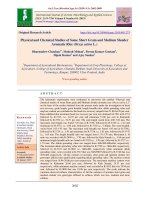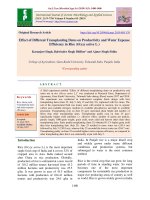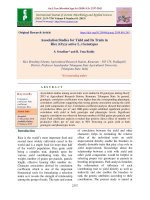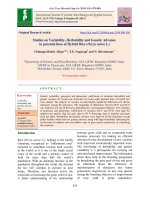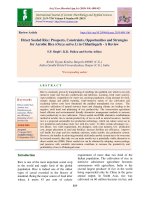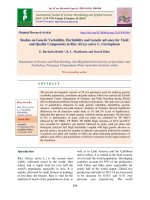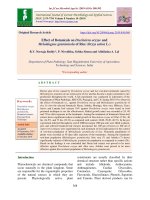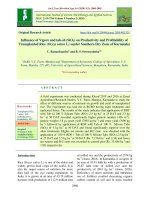Interactive effect of elevated CO2 and temperature on the incidence of brown spot and sheath blight of rice (Oryza sativa L.)
Bạn đang xem bản rút gọn của tài liệu. Xem và tải ngay bản đầy đủ của tài liệu tại đây (200.62 KB, 8 trang )
Int.J.Curr.Microbiol.App.Sci (2017) 6(4): 195-202
International Journal of Current Microbiology and Applied Sciences
ISSN: 2319-7706 Volume 6 Number 4 (2017) pp. 195-202
Journal homepage:
Original Research Article
/>
Interactive Effect of Elevated CO2 and Temperature on the Incidence of
Brown Spot and Sheath Blight of Rice (Oryza sativa L.)
S.K. Dwivedi, S. Kumar, Rahul Kumar*, Ved Prakash, K.K. Rao, S.K. Samal,
Shikha Yadav, Kundan Kumar Jaiswal, Shiv Shankar Kumar,
Basant Kumar Sharma and J.S. Mishra
ICAR-Research Complex for Eastern Region Patna- (Bihar)-800014, India
*Corresponding author
ABSTRACT
Keywords
Rice, kharif,
OTC, Rice
variety and disease.
Article Info
Accepted:
02 March 2017
Available Online:
10 April 2017
Simultaneous increase of (CO2) and temperature causing significant changes in rice crop
growth and productivity, but limited studies has been done in past to examine the
interactive effect of these two key variables on the incidence of brown spot and sheath
blight of rice. Thus, an experiment was conducted at ICAR Research Complex for Eastern
Region, Patna, by growing rice genotypes (Rajendra bhagwati, IR83376-B-B-24-2, IR 64
and IR84895-B-127-CRA-5-1-1) inside open top chambers (OTCs) and open field
condition with two levels of carbon dioxide (ambient and elevated; 500±25 ppm) and
temperature (ambient and ambient+2°C) during kharif season of 2016 in order to
determine their simultaneous effect on incidence of brown spot and sheath blight. One
hour averages of CO2 in the elevated CO2 OTC ranged between 455 and 510 ppm with a
mean of 482 ppm and a standard deviation (S.D.) of 12.7ppm. LAI of the elevated CO 2
treatment was significantly (p<0.05) greater than the control OTC and open field at all
times in both kharif seasons. Brown spot (Helminthosporium oryzae) and Sheath blight
(Rhizoctonia solani) the disease incidence was observed at physiological maturity stage in
kharif season during 2016. The effects of disease on yield contributing characters were
also observed. The incidence of brown spot ranged from 24.91 to 51.25 % and highly
susceptible variety was observed IR-64. The disease incidence of sheath blight of paddy
ranged from 34.33 to 47.08 % and highly susceptible variety was observed Rajendra
bhagwati. It was observed that disease incidence was gradually increased from flowering
stage to maturity stage with the age of the plant and minimum incidence gave the
maximum yield.
Introduction
level to about 2000 m altitude and from
humid areas in eastern India to dry but
irrigated areas of Punjab, Haryana, western
Utter Pradesh and northern Rajasthan.
Rice (Oryza sativa L.) is cultivated under
diverse ecologies, ranging from irrigated to
rain-fed and upland to lowland and deep
water system (Kumar et al., 2014). Globally,
more than 3 billion people have rice as staple
food, and it accounts for 50 to 80 per cent of
their daily calorie intake (Delseny et al.,
2001). Rice is successfully grown from sea
CO2 and temperature are most important
environmental variables
that regulate
physiological and phenological phases in
195
Int.J.Curr.Microbiol.App.Sci (2017) 6(4): 195-202
plants and changes in ambient CO2 and
temperature are likely to occur concomitantly,
it is of particular interest to quantify the effect
of interactions of these two climate variables
on crop (Prakash et al., 2017; Dwivedi et al.,
2015 and 2016; Morison and Lawlor, 1999).
Plant diseases are one of the important factors
which have a direct impact on global
agricultural productivity and climate change
will further aggravate the situation (IPCC,
2007).
Materials and Methods
Disease risk analyses based on host–pathogen
interactions should be performed, and
research on host response and adaptation
should be conducted to understand how an
imminent change in the climate could affect
plant diseases. In Asia, 14.2 per cent of the
potential production costing about US$ 43.8
billion is lost due to diseases (Oerke, 1994).
Climate models predict a gradual rise in CO2
concentration and temperature all over the
world, but are not precise in predicting future
changes in local weather conditions.
The climate of the experimental site is semiarid with dry hot summer and mild winters.
The soil at the experimental site belongs to
the major group of Indo-Gangetic alluvium
(Table 1).
Field experiment
This study was conducted in the experimental
farm of ICAR Research Complex for Eastern
Region, Patna located at 25°35’37" N latitude
and85°05’ E longitude and at an altitude of
51.8 m above mean sea level during 2016-17.
The land area of open-top chambers (OTCs)
had a fairly level topography.
Planting material
Seeds of four genotypes of rice namely
Rajendra bhagwati, IR-64, IR83376-B-B-24-2
and IR84895-B-127-CRA-5-1-1 were grown
inside open top chambers. The field soil
inside the OTCs was dry ploughed and
levelled but not puddled during land
preparation. Twenty one days old seedlings
from wet bed nursery were transplanted at the
rate of one seedling per hill at a spacing of 20
cm x 15 cm in plots. In each plot a uniform
plant stand was maintained and standard
agronomic practices were followed for raising
and maintenance of plants. Plots were
fertilized at the rate of 100:60:40 kg N:P:K
ha–1. Nitrogen was applied on three occasions
(1/3each at transplanting as basal, at active
tillering and panicle initiation), while the P2O5
and K2O were applied as basal application.
The experimental plots were kept weed free
by hand weeding.
Generally rice crop is suffered by more than
17 diseases and certain diseases are more
common on rice varieties than on
conventional varieties. Among the different
diseases brown spot, sheath blight, blast, stem
rot and bacterial leaf blight are considered
important disease at various parts of rice
growing areas of the world. Sheath blight is
an important soil borne disease caused by
Rhizoctonia solani that can cause up to 25 per
cent yield loss (Kumar et al., 2009). Brown
spot of rice caused by Helminthosporium
oryzae can reduce crop yield by up to 40 per
cent. Brown spot disease of rice is also known
as poor disease.
Therefore, present study was undertaken to
determine the interactive effect of elevated
temperature and carbon dioxide on rice brown
spot and sheath blight disease tolerance
attributes in four rice genotypes.
CO2 and temperature treatments
Rice genotypes were exposed to different
levels of temperature and CO2 in different
combinations in open top chambers (OTCs)
196
Int.J.Curr.Microbiol.App.Sci (2017) 6(4): 195-202
starting from sowing up to harvesting stage.
The OTCs used in the study were of
cylindrical shape, fabricated with galvanized
iron (GI) pipe and fixed in the field. The
fabricated sides of structures were covered
with polyvinyl chloride (PVC) sheet having
more than 90% light transmittance to ensure
that light intensity could not be a limiting
factor for the growth of rice crop.
Assessment of the disease incidence
Each plot was visited on regular basis for
recording the incidence. The disease
incidence was recorded in the maturity stages
of the plant. Data were recorded visually by
observing the symptoms.
Ten plants were randomly selected from each
unit plot and the following parameters were
considered for data collection-
All the OTCs were equipped with humidity,
temperature and (CO2) sensors. Pure (CO2)
(99.7%, v/v (CO2) and less than 10 ppm CO)
was released from a commercial grade
cylinder fitted with a regulator. The carbon
dioxide concentration of the air within the
elevated (CO2) chambers was maintained
around the target concentration by a PC-based
real-time data acquisition and control (DAC)
system designed based on the principles
described in Collins et al., (1995). The air
sample from the middle of the chamber was
drawn periodically into a (CO2) sensor
(NDIR, make Topak, USA) to monitor the
(CO2) concentration.
Number of tillers / plants
Number diseased tillers / plants
Percent leaf area diseased (LAD)
Disease incidence was calculated by the
following formula (Rajput and Bartaria,
1995):
Disease incidence = Number of diseased
tillers/
Total number of inspected tillers x 100
Isolation and
organism
The set level of (CO2) was maintained with
the help of solenoid valves which were
controlled by Program Logic Control (PLC)
and Supervisory Control and Data Acquisition
(SCADA) system running win log software
(SELCO, Italy). A data logger recorded the
mean (CO2) within all chambers at 15-min
intervals. The (CO2) supply was switched on
and temperature was maintained only during
the daylight hours (i.e. from 09:00 to 17:00h). In the OTCs with elevated temperature,
reference temperature was obtained from the
control OTC and air temperature was
increased 2oC above ambient chamber by
infra red (IR) heating tubes, and controlled by
the SCADA system. The chambers were
washed regularly with a gentle stream of
water to remove the dust and to maintain
transparency.
identification
of
causal
The symptomatic leaves from the diseased
plants were collected from the field and cut
into small pieces along with healthy portion.
Cut pieces were sterilized by the surface
disinfectants e.g. 0.1% mercuric chloride for
30 seconds. After sterilization the cut pieces
were washed three times with sterile water.
The cut pieces were then placed on sterile
blotter paper to remove excess water. The cut
pieces were then placed on the Potato
Dextrose Agar plate. The plate were labelled
and placed in the incubation chamber for 7
days at 25 + 2o C. After 7 days of incubation,
the fungi grown on culture media. A portion
of culture was taken on slide and observed
under microscope and identified the
pathogenic fungi i.e. Helminthosporium
oryzae, Rhizoctonia solani, with the help of
relevant literature (Mew and Gonzales, 2002;
Barnet and Hunter, 1972). The pathogen, thus
197
Int.J.Curr.Microbiol.App.Sci (2017) 6(4): 195-202
purified, was kept in refrigerator for future
use. All these operations were done
aseptically in the laminar air flow chamber.
The data on different characters were
subjected to estimates of ANOVA (analysis
of variance) by using statistical software
OPSTAT.
Rajendra bhagwati 37.08 per cent and
minimum disease incidence was observed in
IR84895-B-127-CRA-5-1-1 24.91 per cent
followed by IR83376-B-B-24-2 27.25 per
cent. Maximum disease incidence was
observed in open top chamber OTC3 40.08 per
cent followed by OTC4 36.41 per cent and
minimum disease incidence was observed in
OTC1 30.91 per cent followed by OTC2 33.08
per cent.
Results and Discussion
Disease assessment of sheath blight
Daily maximum and minimum temperatures,
maximum and minimum relative humidity,
daily rainfall were recorded from the
meteorological observatory of the ICAR
Research Complex, Patna (Fig. 1). Mean daily
maximum and minimum temperatures and
relative humidity (RH) inside the OTC were
recorded.
Maximum disease incidence was observed in
rice variety Rajendra bhagwati 47.08 per cent
followed by IR-64 37.25 per cent and
minimum disease incidence was observed in
IR84895-B-127-CRA-5-1-1 34.33 per cent
followed by IR83376-B-B-24-2 35.91 per
cent. Maximum disease incidence was
observed in open top chamber OTC3 43.91 per
cent followed by OTC4 42.41 per cent and
minimum disease incidence was observed in
OTC1 31.58 per cent followed by OTC2 36.66
per cent.
Analysis of data
Disease assessment of brown spot
Maximum disease incidence was observed in
rice variety IR-64 51.25 per cent followed by
Table.1 Soil characteristic of experimental site
Sand
(%)
Silt
(%)
Clay
(%)
Organic Soil
carbon pH
(%)
BD
EC
3
(mg m ) (dSm-1)
Nitrogen Phosphorus
(kgha-1) (kgha-1)
Potassium
(kgha-1)
29.5
41.5
28.0
0.67
1.45
237
203.2
7.3
0.26
27.0
Table.2 Description of treatment combinations
Treatments
Description
OTC1
Ambient Condition
OTC2
25 % higher CO2 than ambient
OTC3
25 % higher CO2 + 20 C> ambient temperature
OTC4
20 C> ambient temperature
198
Int.J.Curr.Microbiol.App.Sci (2017) 6(4): 195-202
Table.3 Disease severity scale of brown leaf spot and sheath blight
Name of diseases
Brown Spot
Sheath Blight
Scale
1 = No incidence
2 = Less than 1%
3 = 1-3%
4 = 4-5%
5 = 11-15%
6 = 16-25%
7 = 26-50%
8 = 51-75%
9 = 76-100%
0 = No infection observed
1 = Lesions limited to lower 20% of the plant
height
3 = 20-30%
5 = 31-45%
7 = 46-65%
9 = More than 65%
Table.4 Incidence of brown spot of paddy
Treatment
Rajendra
Bhagwati
OTC1
32.33
OTC2
36.33
OTC3
42.00
OTC4
37.66
Mean (V)
37.08
IR-64
46.66
50.00
55.33
53.00
51.25
IR83376-BB-24-2
22.66
25.00
32.33
29.00
27.25
IR84895-B127-CRA-51-1
22.00
21.00
30.66
26.00
24.91
Mean (O)
Factors
Factor (V)
Factor (O)
Factor (V X
O)
30.91
C.D.
2.16
2.16
NS
33.08
SE(d)
1.05
1.05
2.11
40.08
SE(m)
0.74
0.74
1.49
36.41
199
Int.J.Curr.Microbiol.App.Sci (2017) 6(4): 195-202
Table.5 Incidence of sheath blight of paddy
Treatment
Rajendra Bhagwati
IR-64
IR83376-B-B-24-2
IR84895-B-127CRA-5-1-1
Mean (O)
Factors
Factor (V)
Factor (O)
Factor (V X O)
OTC1
38.00
31.00
29.33
28.00
OTC2
42.33
35.33
35.33
33.66
OTC3
55.33
42.33
40.00
38.00
OTC4
52.66
40.33
39.00
37.66
31.58
C.D.
1.97
1.97
NS
36.66
SE(d)
0.96
0.96
1.92
43.91
SE(m)
0.68
0.68
1.36
42.41
Mean (V)
47.08
37.25
35.91
34.33
Table.6 Test weight of rice in different treatments under OTC conditions
Treatment
Rajendra
Bhagwati
OTC1
OTC2
OTC3
OTC4
Mean (V) g
27.34
26.47
29.77
28.13
24.98
IR-64
IR83376-B-B24-2
IR84895-B-127CRA-5-1-1
Mean (O)
Factors
Factor (V)
Factor (O)
Factor (V X O)
25.63
27.65
22.49
24.04
24.95
28.54
25.79
26.99
25.36
26.67
25.91
28.50
27.27
25.73
26.85
26.63
C.D.
1.24
1.24
2.49
27.93
SE(d)
0.60
0.60
1.21
26.22
SE(m)
0.42
0.42
0.85
25.03
Fig.1 Weather conditions during the period of study at experimental site
200
Int.J.Curr.Microbiol.App.Sci (2017) 6(4): 195-202
incidence was recorded on IR-64, whereas the
lowest incidence was observed on IR84895B-127-CRA-5-1-1. But in case of sheath
blight, the highest incidence was recorded on
Rajendra bhagwati whereas the lowest
incidence was observed on IR84895-B-127CRA-5-1-1. There has been only limited
research on impact of climate change on plant
diseases under field conditions or disease
management under climate change. Such
kinds of study, will provide a new sight to
crop improvement programme for the
development of more resilient rice varieties
for the geo-graphical region where rice is the
major food crop and highly vulnerable to
changing climatic conditions.
Test weight of rice
Maximum test weight was observed in rice
variety Rajendra bhagwati 27.34 g followed
by IR84895-B-127-CRA-5-1-1 26.85 g and
minimum test weight was observed in IR-64
24.95 g followed by IR83376-B-B-24-2.
Maximum test weight was observed in open
top chamber OTC2 27.93 g followed by
OTC1. 26.63 g and minimum test weight was
observed in OTC4 25.03 g followed by OTC3
26.22 g.
Research over the past few years suggests that
the most likely impact of elevated (CO2) on
plant disease epidemics would be mediated
through changes in the host physiology and
morphology. Results of the study indicate that
exposure to elevated temperature enhanced
the progress of disease in both genotypes as
compared to elevated CO2 exposure. Boland
et al., (2004) also reported that stress of drier
and warmer growing conditions increases the
severity of different diseases of maize caused
by fungi with necrotrophic mode of nutrition
as recorded in case of common smut caused
by Ustilago maydis, Fusarium ear rot caused
by Fusarium spp. and Stewart’s disease
caused by Erwinia stewartii. Infection rate of
powdery mildew was low in barley plants
grown in 700 ppm CO2 concentration as
reported by Hibberd et al., (1996). Contrary
to these, Kobayashi et al., (2006) found
increased incidence of rice sheath blight
caused by Rhizoctonia solani (necrotrophic)
at the CO2 concentration of 280 ppm higher
than ambient CO2 level. Sharma et al., (2007)
reported increased severity of necrotrophic
fungus Cochliobolus sativus causing spot
blotch in wheat under high night temperature,
especially in March (30–35oC, averaged over
6 years), when evaluated over a 6 year period.
Acknowledgement
The authors are grateful to the authors also
acknowledge to ICAR-Research Complex for
Eastern Region, Patna for providing research
facility.
References
Barnett, H.L., Hunter, B.B. 1972. Illustrated
genera of imperfect fungi, Burgess
Publishing Company, pp: 241.
Boland, G., Melzer, M., Hopkin, A., Higgins,
V., Nassuth, A., 2004. Climate change
and plant diseases in Ontario. Can. J.
Plant Pathol., 26: 335–350.
Delseny, M., Salses, J., Cooke, R., Sallaud,
C., Regad, F. 2001. Rice genomics:
Present and future. Plant Physiol.
Biochem., 39: 323-334.
Dwivedi, S.K., Kumar, S., Prakash, V.,
Mondal, S., Mishra, J.S. 2015. Influence
of
rising
atmospheric
CO2
concentrations and temperature on
morpho-physiological traits and yield of
rice genotypes in sub humid climate of
Eastern India. Amrican J. Plant Sci., 6:
2339-2349.
In conclusion all four varieties were noticed
as susceptible against brown spot and sheath
blight disease. For brown spot, the highest
201
Int.J.Curr.Microbiol.App.Sci (2017) 6(4): 195-202
Dwivedi, S.K., Kumar, S., Prakash, V.,
Mishra, J.S., Singh, S.S., Kumari, S.
2016. Influence of elevated CO 2 and
temperature on physiological traits and
yield attributes of heat tolerant wheat
genotype Halna grown inside open top
chambers. Ind. J. Plant Physiol., pp 17.
Hibberd, J., Whitbread, R., Farrar, J. 1996.
Effect of 700 mmol_1 CO2 and
infection by powdery mildew on the
growth and carbon partitioning of
barley. New Phytol., 134: 309–315.
IPCC. 2007. Intergovernmental Panel on
Climate Change, Climate Change, The
Fourth IPCC Assessment Report,
Cambridge
University
Press,
Cambridge, UK.
Kobayashi, T., Ishiguro, K., Nakajima, T.,
Kim, H., Okada, M., Kobayashi, K.
2006. Effects of elevated atmospheric
CO2 concentration on the infection of
rice
blast
and
sheath
blight.
Phytopathol., 96: 425–431.
Kumar, K.V.K., M.S. Reddy, J.W. Kloepper,
K.S. Lawrence, D.E. Groth and M.E.
Miller. 2009. Sheath blight disease of
rice (Oryza sativa L.): An overview.
Biosci. Biotechnol. Res. Asia, 6: 465480.
Kumar, S., Dwivedi S.K., Singh S.S.,
Elanchezhian, R., Mehta, P., Singh,
B.P., Singh, O.N., and Bhatt, B.P. 2014.
Morpho-physiological traits associated
with reproductive stage drought
tolerance of rice (Oryza sativa L.)
genotypes under rain-fed condition of
eastern Indo-Gangetic plain. Indian J.
Plant Physiol., 19(2): 87-93.
Mew, T.W., Gonazales, P. 2002. A handbook
of rice seed bore fungi, International
Rice Research Institute, Los Banos,
Philippines. 2002; pp: 20.
Morison, J.I.L. and D.W. Lawlor. 1999.
Interactions between increasing CO2
concentration and temperature on plants
growth. Plant, Cell and Environ., 22:
659‒682.
Oerke, E.C., Dehne, H.W., Schonbeck, F. and
Weber, A. 1994. Crop Production and
Crop Protection: Estimated Losses in
Major Food and Cash Crops,
Amsterdam Elsevier.
Pareja, L., Fernandez-Alba, A.R., Cesio, V.,
Heinzen, H. 2011. Analytical methods
for pesticide residues in rice. TrAC
Trends in Anal. Chem., 30: 270-291.
Prakash, V., Mishra, J. S., Kumar, R., Kumar,
R., Kumar, S., Dwivedi, S. K., Rao, K.
K., and Bhatt, B.P. 2017. Thermal
utilization and heat use efficiency of
sorghum cultivars in middle IndoGangetic Plains. Mausam: In Press.
Rajput, R.L. and A.M. Bartaria. 1995.
Reaction of rice cultivars to brown spot.
Agric. Sci. Dig. J., 15: 205-206.
Sharma, R.C., Duveiller, E., Ortiz-Ferrara, G.
2007. Progress and challenge towards
reducing wheat spot blotch threat in the
Eastern Gangetic Plains of South Asia:
is climate change already taking its toll?
Field Crops Res., 103: 109–118.
How to cite this article:
Dwivedi, S.K., S. Kumar, Rahul Kumar, Ved Prakash, K.K. Rao, S.K. Samal, Shikha Yadav,
Kundan Kumar Jaiswal, Shiv Shankar Kumar, Basant Kumar Sharma and Mishra, J.S. 2017.
Interactive Effect of Elevated CO2 and Temperature on the Incidence of Brown Spot and
Sheath Blight of Rice (Oryza sativa L.). Int.J.Curr.Microbiol.App.Sci. 6(4): 195-202.
doi: />
202

